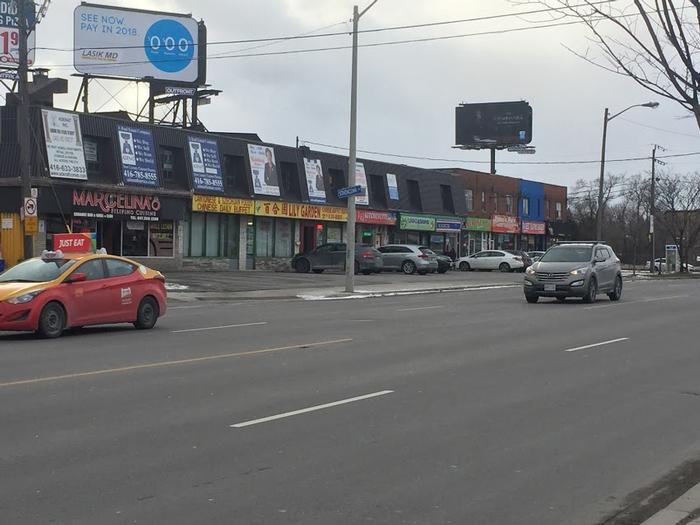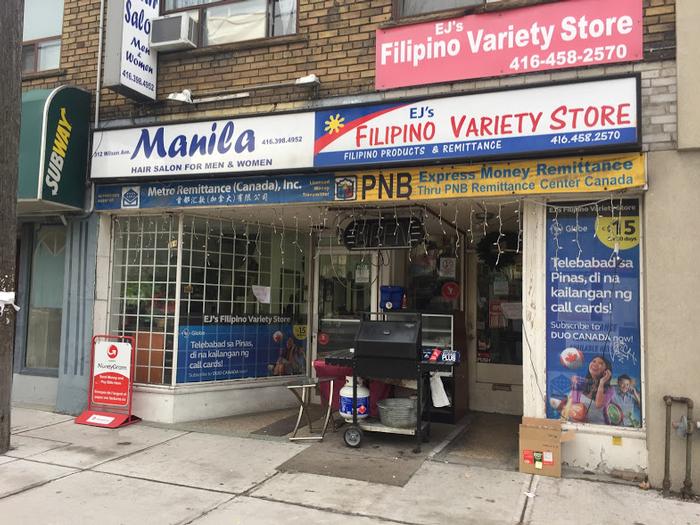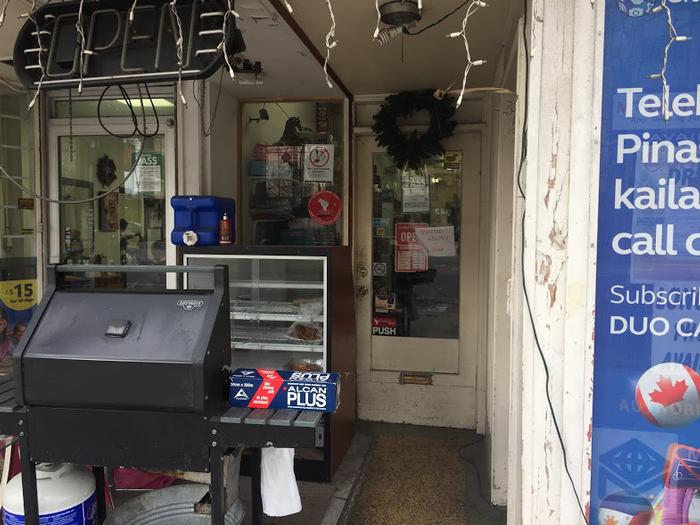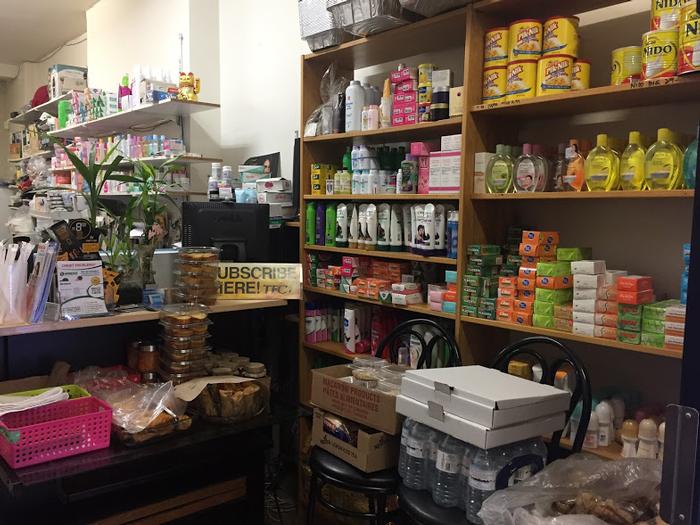Jan Doroteo EssayThe Little Pinoy Sari-Sari Store: Of Otherness and Belonging in a Global Diaspora"Society for the Filipino is a small rowboat: the barangay. Geography for the Filipino is a small locality: the barrio. Industry and production for the Filipino are the small immediate searchings of each day: isang kahig isang tuka. Commerce for the Filipino is the smallest degree of retail: the tingi. [and] Enterprise for the Filipino is a small stall: the sari sari." -Nick Joaquin "A Heritage of Smallness" When I visited Toronto’s Little Manila district at the intersection of Wilson Avenue and Bathurst Street in the suburb of North York, I did not find what I wanted to see. I wanted to find monumental structures that could represent the hardships and successes of Filipino immigrants in Toronto. What I found along the busy road near an underpass leading to the freeway were run-down strip malls. And in these strip-malls were dozens of small hole-in-the-wall convenience/variety stores—they just had that look of a "mom and pop shop." In Filipino, we call these Sari-Sari stores. They are located in large numbers in many cities worldwide, and certainly many along Little Manila. I wondered if these structures were the embodiment of the overseas Filipino community. Particularly I wondered: Is this it? It seemed paradoxical to my statistical research. I am one of 700 000 ethnic Filipinos who call Canada home. As Filipino-Canadians, we are the fastest-growing immigrant population in the nation, even surpassing both India and China, both of whose populations vastly exceed that of the Philippines. As a visible minority group, we are the fourth-largest (Coloma). Amidst this considerable presence, is what seems like invisibility on the urban landscape. Where were the Filipinos churches and community centres? My initial observations only seemed to reinforce the collective insecurity of Filipinos. As Nick Joaquin, the Philippines’ own National Artist for Literature points out: our icons (which includes the Sari Sari store) points towards the inadequacy of being small. I wanted to resist these notions. As an aspiring architect, I needed to remind myself that the primary importance of architecture is to support habitation. It needs to serve, first and foremost, the people who occupy these structures. Having visited Sari-Sari stores countless times, I know that it is otherwise an extremely useful and empowering architectural typology to the Filipino. To study its form, program, structure and site(s) is to peel back and unfold the many complicated (and often contradictory) layers of narratives that make us uniquely and honourably Filipino. I knew that to discover its more subtle attributes was to uncover a dignified symbol of the Filipino community. Smallness In promoting the Sari-Sari store as a dignified icon, I know that I will provoke many, particularly my fellow Filipinos. Even when it is a viable source of income, the Sari-Sari is an icon of self-deprecation and belittlement because our national identity is complicated by our colonial mentality. We find our products to be small only in comparison to other cultures. Providing a new reading of the architecture of the Sari-Sari store is to target our very insecurities. I sought to understand the Sari-Sari store for its value to its actual users. If these stores are typified best by their size, then I argue that it is the very smallness of the Sari-Sari which is the reason for its success. Its emergence is a direct result of the user’s needs. While it may be small, it conceals a richness that is representative of the Filipino in the face of modern 21st century diaspora. Smallness is expedient, smallness is intimate, smallness is intense, and smallness represents one piece of a larger whole. As an aspiring architect, these are elements that I know can adopt into my craft. Typology The Sari-Sari store is a well-entrenched building type in the Philippines. In the homeland, these stores are a common sight in residential areas, and it has always been small. Many lower middle-class families maintain a storefront in a small partitioned section of their home as a source of income. Similar to what I found along Little Manila, dozens would line the same street generally selling the same domestic consumer products. As Joaquin points out in his essay, these stores sell in "tingi" which means that products that would normally come in large bottles such as shampoo would be sold as portioned packets. Things that would come boxed as multiples, like cigarettes, would be sold per piece. These "tingi" sized products are the only price point affordable to the impoverished and serves to undercut economic barriers. The only "downside" is that they make Sari-Sari stores look kitschy and unorganized. The diminutive scale of the Sari-Sari represents a beacon of hope for many. In American talk shows like The Ellen Degeneres show the host is known for awarding life-changing presents to its viewers. In the Filipino version of these shows, the host would present a "Sari-Sari Store Package" as a gift to a lucky viewer thus suggesting that anyone can own a store, and it can be placed anywhere. As a building type, it takes an expedient built form readily deployed at any given notice as direct improvement to a family in need. These prizes are also called "Kabuhayan (Livelihood) Packages" which underscore truly what the Sari-Sari store can be: an empowering source of livelihood and upward mobility. Export My visit to Little Manila initially left me with the impression of feeling miniscule. With a collection of "big box" surplus warehouses located in close proximity to the district, I could not help but make comparisons. In this instance, our Filipino productions did seem Lilliputian to the scale of the Western world. Though it is worthy to mention the number of Sari-Sari stores far outnumbered the warehouses. They seemed like clusters of pebbles surrounded by giant boulders. Architects argue towards the value of small and compact architecture because it is easily deployed, able to fit into various contexts and is often a way to circumnavigate larger institutional barriers. For this, the Sari-Sari represents an empowering architectural typology, and our best export from the home land. In the same way that the humble operations of the Sari-Sari store undercuts poverty, the overseas Sari-Sari store allows immigrants to penetrate the North American market. Many Filipinos emigrate out of the country because of financial difficulties. However, barriers to employment also exists in foreign communities due to cultural differences (Polvorosa). Given the strong entrepreneurial culture in the Philippines, many seek to business ownership, but the start-up costs of mainstream ventures are significant and there is often a need for extensive network. The Sari-Sari is an architecture that is easily built and propped up because of its smallness. It means that customer expectations are realistically low; it means that start-up costs are economical; it means that an immigrant family could be self-employed without needing additional staff; and it means that would be business owners are poised to take advantage of undesired and challenging retail spaces. Most importantly, the business owners are serving the micro-economy of their ethnic community. As exports, the stores have also adapted to their new context. Overseas Sari-Sari stores also offer international phone cards, money remittance and shipping services. The overstocked appearance of Sari-Sari stores is an embodiment of the immigrant’s clamor for success—that most times their hard work is their sole capital. As a symbol on the North American Landscape, the Sari-sari represents willful autonomy and self-determination. Against these big box stores, I now see them as little pockets of resistance and an architectural statement of critical regionalism that is rooted in shrewd pragmatism. Otherness I had difficulty finding more conventional ethnic spaces because Filipinos take pride in their ability to adopt Western culture. We are largely Roman-Catholic. We regard our English literacy as indicators of our intelligence. And others quip that hip-hop has become the national dance of the country. I couldn’t seek out a temple, a language school or a performing arts theatre here in Toronto. These kinds of places, for many cultures, represent Safe Spaces of Otherness where individuals feel more open to partaking in local practices and behaviour. The Sari-Sari in overseas communities like Toronto, represents this safe space. It is a space for Filipinos just to be Filipino. Shrouded away from other cultures, we are not pressured to "perform" in our Western ways; it is a space that is flexible to our complicated and contradictory ethnic identities as neo-colonial subjects. As seen in image 2, the entrance of the Sari-Sari is often buried by the elements in front of it. In some cases these are just empty shipping boxes, or bundles of free ethnic newspapers because there is no space left inside the store. In this case, it’s a domestic barbecue grill used by the shopkeepers to sell barbecue sticks by the piece. The limited window space available for sunlight is instead completely used up by the shopkeepers as advertisement space for posters and notices. In maximizing the visibility of the store to those familiar with it, the shop owners actually obscure the space for those unfamiliar. The entrance to the space, in turn, now asks for a certain deliberateness of entry. Without any discriminatory actions the store carves out a space for Filipinos. Obscured from foreigners, the intimacy of the space announced a change of social values upon my entry. I felt this immediately upon noticing the products in the store. Ethnic products appeal to a niche audience with an acquired taste. That statement holds true for the many dried fishes and fermented sauces that Filipinos consume. Yet overseas, we consume these products in disgrace. In my own home, the dried fish and fermented sauces are tucked away in the least accessible cupboard. In the store, these products were displayed out in the open. I know that my fellow Filipinos and I only pretend like the scent bothers us at home which is why we hide them. In the Sari-Sari we can act like it doesn’t bother us, because it really doesn’t. More importantly, this new "cultural zone" affected the social interactions in the space. Knowing that I was inside the Sari-Sari, I felt more free to approximate people’s ages, as we would normally do in Philippine culture, so that I could address them with the proper title. Those older than me were addressed "Ate and Kuya" while it was "Manong and Manang" for the elders. I, myself, am transformed in these interactions. Complete strangers would now address me as "anak" a term of endearment that roughly translates to "my child." These are quick interactions, but their intensity is remarkable. In our fast-paced urban lives, this expedited intimacy is critical. In public spaces, often, our interactions with others are limited to mere seconds of pleasantries. In the small confines of the Sari-Sari store, those few seconds with kindred spirits are maximized. Experience Having always gone to the Sari-Sari stores with my parents, I hesitated to enter when I went to visit alone as part of my research. Only during that trip, did I realize how the experience affected all of my senses. I was transported to the messy and vibrant homeland. Since the store sold food, I already expected my senses of taste and smell to be stimulated. Feelings of childhood nostalgia were awoken in me upon smelling the sweetness of the barbecued meat sticks. I certainly bought one to enjoy at home. That said, I did not expect my hearing and sight to affect my sense of identity inside the space. I felt like I belonged in my environment. Inside, there was a small but very loud TV propped up in a corner that was playing a Filipino soap opera, repeating versions of the same tired old dialogues I’ve heard before. Along one side of the store walls were a collection of Filipino cosmetics that displayed the faces of people that looked like me (Image 3). All over the walls, were advertisement posters with "Taglish" slogans and Filipino humour. As an enveloping environment, it normalized the Filipino spirit even for just a temporary moment and brought me back to the Philippines. In architecture, I believe that smallness has an agency. For the Sari-Sari, the small tight confines of the store amplified sensual effects on the individual. If the Sari-Sari were as large and universalized as ethnic supermarkets, the space would be sterile and contrived. The open space and regulated dimensions of the space would dilute the intensity. The high-tech HVAC system would quickly waft away the unique aroma of the products, and the paid multicultural staff are probably too busy counting stock. For those Westernized spaces, their efforts are to attract as many different types of customers as possible (Polvorosa). Building camaraderie, occasionally, requires intensity in small doses. For the Filipinos, the Sari-Sari store provides just that. Territory My feelings of nostalgia are always amplified in a Sari-Sari store, but this is not to say that these buildings are regressive pieces of novelty that are frozen in time. These stores are, actively, agents of modernity for the Filipino Diaspora. They perform like de facto community centres and serve as virtual networks for a massive territory. Within the tight confines of these stores, is a world of connectivity both locally and internationally. In it suburban setting, the Sari-Sari stores in Little Manila serve as epicentres for a dispersed Filipino population. As a central meeting point, the Sari-Sari store, though ultimately not profiting from these activities, becomes a networking zone. In the stores, material goods aren’t the only things traded but also valued information. On one designated wall of the Sari-Sari store is a bulletin board with hand-written notes of job advertisements, available boarding rooms, and day care services. The shopkeepers themselves are treasure troves of pertinent information and hear-say, often providing little tips to the shoppers. Even in this context, the performativity of this architecture is shaped by everyday practical use. In the diasporic condition of Filipinos, forms of bonding between distant family members become technocratic and digital. These include the monthly remittance of money to the Philippines, the annual shipping of "balikbayan" boxes filled with simple domestic goods and products, long-distance calling, and subscribing to "The Filipino Channel." In Toronto, the Sari-Sari is the purveyor of these services acting as a mediator to human connections. The global operations of the Sari-Sari, transform the products between family members. Money becomes parental responsibility, the teddy bear in the box is a loving touch, and the TV show becomes petty neighbourhood gossip. It makes me see the Sari-Sari store as a conduit to operations larger than its physical confines, but always rooted in human interaction. It is as if the smallness of the Sari-Sari store is only a front to a global sphere of operations, like satellite towers acting independently but connecting a large network. Across sovereign borders, the Filipinos carve out a territory that is their own. The Sari-Sari store is a hardworking architectural unit and a one-stop-shop not only for my community in Toronto, but to many overseas Filipino communities worldwide. I think specifically, that intellectual moment is teased by Image 3 when home-baked goods are cheekily juxtaposed with a TV subscription advertisement. In all of its depth and plurality, the lowly Sari-Sari store is a symbol of a dignified architecture for the Filipinos. Bottom-Up Architecture Reflecting upon my culture through the Sari-Sari store gave me a deeper and more stable sense of identity. Yet I do not find that as the greatest takeaway out of my analysis. Over the last few weeks, I wondered often whether I should introduce improvements to the Sari-Sari store: open interiors, minimal decorations, and a larger entrance. Would I still be able to promote the same narrative of empowerment? As architects, we often feel like the heroes of the saga, sweeping in to save the day (Cabalfin). Are the masses forever the victims? Are we unable to recognize their own agency? In the end, this essay is not about the power of architecture, but rather of its subservience. Buildings are openly configurable by its inhabitants. As architects, our purest ability is to be able to reproduce elements of successful precedents. Most critical to this process is for the architect to observe, to listen and to ask. As architect and fellow Filipino Edson Cabalfin writes: "Architects should go beyond thinking of the architectural object as the ultimate goal, and consider the processes that engender the designed environment. Architecture is a system, rather than an isolated object." We need to see how people are able to take hold of their own lives in buildings. From here, we can build architecture from the bottom-up. To that, I challenge the reader. What can we then learn from the Hispanic bodega, the schoolhouse under the bridge, the farmer’s markets, or even the multi-family McMansions of the suburbs? Works Cited and Works Consulted Cabalfin, Edson. "Paradigm Shift: A Manifesto Towards an Architecture that is Inclusive, Humane and Empowering." Bluprint Magazine Oct. 2015:36-39. Academia.edu. Web. 20 Jan 2017. Coloma, Roland S. Filipinos in Canada: Disturbing Invisibility. Toronto: University of Toronto Press,2012. Joaquin, Nick. "A Heritage of Smallness." Culture and History by Nick Joaquin. Pasig City: Anvil Publishing, Inc., 1988. 351-367 Polvorosa, Cesar Jr. "Toronto Filipino Businesses, Ethnic Identity, and Place Making in the Diaspora." Filipinos in Canada: Disturbing Invisibility Toronto: University of Toronto Press, 2012. 181-200. Sewell,John. The Shape of the Suburbs: Understanding Toronto's Sprawl. Toronto: University of Toronto Press, 2009. Sen, Arijit, and Lisa Silverman. Making Place: Space and Embodiment in the City. Bloomington, Indiana: Indiana University Press, 2014. Print. Linovsky, Orly. "Beyond Aesthetics: Assessing the Value of Strip Mall Retail in Toronto" Journal of Urban Design 17:1. London:Routledge. 81-99. Additional Help and InformationAre you in need of assistance? Please email info@berkeleyprize.org. |




